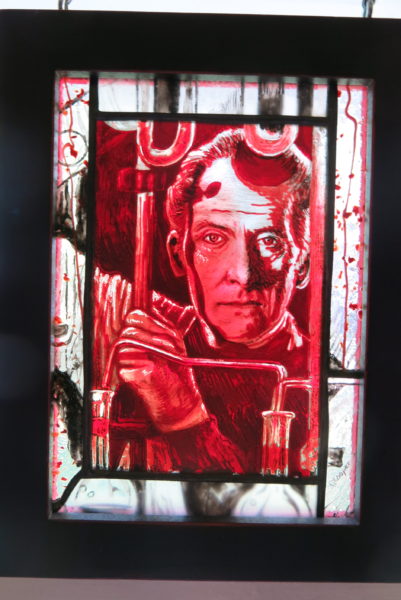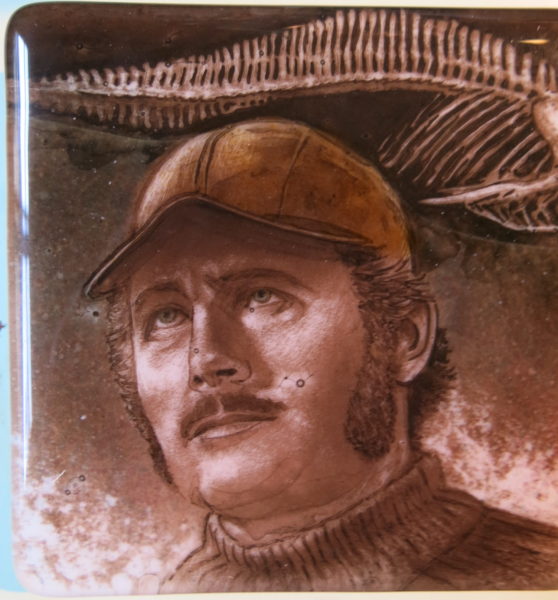
Artist Fellowship Spotlight – Rob Cooper, Jackson, Miss.
By Larry Morrisey, MAC Deputy Director
This past July, MAC awarded grants to 14 Mississippi artists through the Artist Fellowship Program. The grant program provides up to a $5,000 award to individual artists who demonstrate a high level of excellence in their work. This year’s recipients are from nine different communities and represent several different artistic genres, including photographers, writers, painters and musicians.
Rob Cooper has spent his artistic life surrounded by glass. The Jackson-based artist has spent most of his years as an active artist working at Pearl River Glass Studio, a commercial studio that creates stained glass windows, architectural art glass and restores historic stained glass. He currently works as one of the glass artists for the studio, painting imagery on the stained glass windows and other glass artwork they create for churches, private residences and commercial clients.

Rob Cooper drawing at his home studio
Cooper got his start at Pearl River Glass while in high school, doing an internship at the studio through the APAC arts program at Jackson Public Schools. He spent some time studying outside of Mississippi, earning a BFA at the Maryland Institute College of Art in Baltimore. Afterwards, he returned to Jackson and continued his work at Pearl River. “I’ve worked all the way through every level (at the studio),” he explains. He learned each of the jobs in the process, from leading the windows to cutting glass.
When he gets home from the studio, Cooper creates his own work. Over the past decade, he has developed distinctive fused glass pieces. He has taken his experience painting Biblical figures for stained glass window commissions into his own work. Many of his pieces have focused on iconic figures from arts and culture, including musician Alice Coltrane, author Edgar Allan Poe, and actor Peter Cushing.

Coopers piece depicting actor Peter Cushing
While Cooper masterfully captures the essence of many legendary artists, he tries to not plan his pieces too much. He avoids making sketches on paper, always starting the “problem solving” phase of a work on the glass.
“Glass is a really interesting medium, in that it’s not predictable,” he explains. “You can learn from the times you’ve done it in the past what the outcome should be, but it’s always a little bit different and that keeps it interesting. I use glass as a sketchbook a lot of times. . I’ll spread some paint out on the glass and just work it and see what happens.”

Glass art depicting actor Robert Shaw
This is the second Artist Fellowship Cooper has been awarded by MAC. He received his first in 2011, which he used to complete new work that he shared through a number of gallery shows in central Mississippi. He acknowledges the first Fellowship played an important role in the development of his work at the time.
“I was in the middle of building a body of work to have a show,” he recalls. “(The Artist Fellowship) was a tremendous help. I did some of my most ambitious work then and I was able to put a lot of attention on it and even take some time off work to really push the pieces I was doing.”

Rob Coopers depiction of singer Ian Curtis of Joy Division on glass
At home, Cooper is not unique in his artistic pursuits. His wife Wendy Eddleman and their children Lucy and Theo are all active visual artists. Creating new work is a part of their everyday lives together. “We’ll sit down like everyone else does to watch a movie, but sometimes we’ll be like, ‘Let’s just hang out and draw,’” he explains. He gave his children art lessons when they were younger, but now that they are in high school and middle school, Cooper tries to stay out of their way creatively. “Now that they’re older, they have their own vision and they don’t want too much instruction from me because they’re very creative themselves,” he says.

Cooper with a piece depicting his wife, artist Wendy Eddleman
While he has spent the last several years making work for commissions and gallery shows, Cooper plans to spend at least part of his Fellowship year deepening his knowledge of the history of the art form and trying to find ways to incorporate classic design elements into his own work.
“I’m trying to re-educate myself and learn more about the history of stained glass and bringing that to what I do,” he says. “I don’t want to get too wrapped up in one style where that’s what I’m known for. That works great for getting recognition, but at the same time I don’t receive as much satisfaction from it.”
